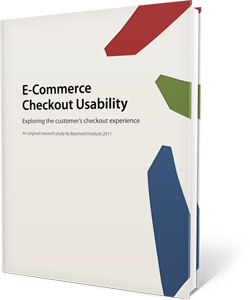 I recently read Smashing Magazine’s State of ECommerce Checkout Design 2012 which analyzes the usability of 100 ecommerce checkout processes, based on research from the Baymard Institute.
I recently read Smashing Magazine’s State of ECommerce Checkout Design 2012 which analyzes the usability of 100 ecommerce checkout processes, based on research from the Baymard Institute.
I learned that many companies violate usability best practices in terms of:
- The length of their checkout process
- Account registrations
- Newsletter sign-ups
- Address validations
I noticed that most of the websites in this report sold physical products and the only pure software companies featured in the report were Symantec (which offers a traditional on-premise software) and Ancestry.com (which offers a SaaS product). This blog post shows the report’s highlights and extrapolates lessons for the software world.
Is your checkout process too long?
Beach Body LLC uses a one-step checkout process that includes product information, price, payment information, access to account information and shipping address on one page. Apple on the other hand, has all this information laid out for customers in seven separate pages.
What is the optimal length of a checkout process? Beach Body thrives on a short checkout process while Apple thrives on a longer one.
If you currently use a multiple-step checkout processes and you need to bump up conversions, I suggest performing multivariate tests with simpler checkout processes and vice versa – if you use a single or two-step checkout process maybe customers find your cart too cluttered and busy. Try testing out a longer, but clearer path to conversion.
Customer confusion is the one thing you absolutely want to avoid. Many B2C customers are not as cyber savvy as someone who lives and breathes technology, so “clarity” should always trump “cool.”
B2B customers may need additional support, and the experience of being guided through an important purchase with a step-by-step approach is more appropriate for them.
If you want to find out what really works for your customers, don’t be afraid to perform multivariate tests on your checkout process.
Do you require account registration?
Consider this: If I lived in a neighborhood with two malls close to my house, one which required me to become a member before I could buy anything and one which let me enter and buy without becoming a member, I would likely choose the latter.
But what if the first mall had better quality products and cheaper prices, and the only barrier to membership was my name and contact information? The first mall’s membership policy is no longer too cumbersome. The second mall’s laissez-faire entrance policy is also not advantageous enough to outweigh the benefit of the better selection and prices of the first mall. Think Walmart vs. Sam’s Club.
An account creates a central location for every customer’s order and product information, and is beneficial to them. Without accounts, customers would have to manage their own data. For consumers, it’s a relief to know that the merchant is handling the storing and organization of their information.
But online shoppers shop at many stores, and keeping track of every account is difficult. The experience of trying to recall this information on demand can lead to confusion, frustration and ultimately cart abandonment.
Don’t make customers create an account or login before purchasing. Rather, use customer information from the checkout process to create an account on the customer’s behalf. The account information can be presented on the customers confirmation page, thus providing them a useful account without disrupting their shopping experience.
If you already have an extensive customer account section, be sure that your ecommerce system is tied tightly via single sign-on technology.
Is your newsletter opt-in or opt-out?
One important finding from Baymard’s usability tests is that users often equate newsletters with spam. Despite your marketing department’s best efforts, shoppers sometimes do not care for the content created on their behalf.
Yet, according to the Ecommerce Blog by Shopify, newsletters can be useful for:
- Capturing new leads
- Communicating with current customers
- Positioning yourself as an industry expert
- Nurturing leads until they become customers
If you are going to offer newsletters, it is important to test the efficacy of offering opt-in and opt-out.
First measure how well your newsletters are performing against the goals you’ve set. Then route half your visitors to a cart where your newsletter is opt-out and and half your visitors to a cart where your newsletter is opt-in.
Whichever cart performs better is the right way to go.
Is your address validation confusing buyers?
Software companies seem to have little reason to worry about address verification. After all, most of your products are delivered electronically.
However, even software companies ship physical products in the form of backup CDs. Further, banks and card issuers will offer fee reductions to companies that collect important pieces of data like ZIP codes, which goes a long way toward fraud prevention.
These are only several reasons why it is important to make sure your customers are providing correct information. The only caveat to this practice is that it is equally important not to prevent customers from completing an order if they insist they are providing correct shipping information.
It’s all about abandondment.
The average cart abandonment rate for ecommerce sites is around 66%. That means 66% of the people who found your product and decided to buy it experienced a sudden change of heart during the checkout process.
Imagine if this sort of behavior happened at your local grocery store. What if visitors spent 20 minutes shopping in the aisles of a store, placing items in their cart, lining up for the checkout and then suddenly run out the door, abandoning the cart in the middle of the line.
Keystone
A clear, well-designed checkout process is crucial to your conversion rate. Perform testing to determine which elements are leading to success and which elements are leading to abandonment.